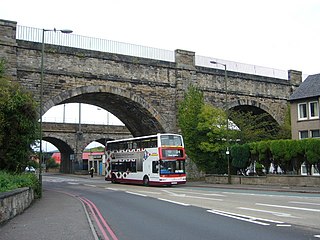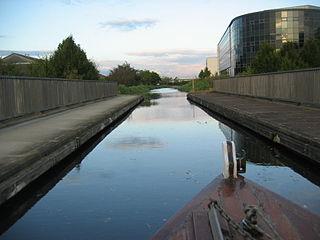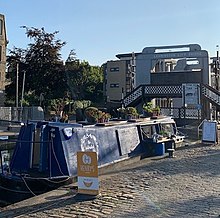
The Forth and Clyde Canal is a canal opened in 1790, crossing central Scotland; it provided a route for the seagoing vessels of the day between the Firth of Forth and the Firth of Clyde at the narrowest part of the Scottish Lowlands. This allowed navigation from Edinburgh on the east coast to the port of Glasgow on the west coast. The canal is 35 miles (56 km) long and it runs from the River Carron at Grangemouth to the River Clyde at Bowling, and had an important basin at Port Dundas in Glasgow.

The Falkirk Wheel is a rotating boat lift in Tamfourhill, Falkirk, in central Scotland, connecting the Forth and Clyde Canal with the Union Canal. It reconnects the two canals for the first time since the 1930s. It opened in 2002 as part of the Millennium Link project.

The Union Canal, full name the Edinburgh and Glasgow Union Canal, is a canal in Scotland, running from Falkirk to Edinburgh, constructed to bring minerals, especially coal, to the capital. It was opened in 1822 and was initially successful, but the construction of railways, particularly the Edinburgh and Glasgow Railway, which opened in 1842, diminished its value as a transport medium. It fell into slow commercial decline and was closed to commercial traffic in 1933. It was officially closed in 1965. The canal is listed as three individual scheduled monuments by Historic Scotland according to the three former counties, Midlothian, West Lothian and Stirlingshire, through which it flows.

The Forth and Clyde canal pathway runs between the Firth of Forth and the Firth of Clyde and is a 106-kilometre-long (66 mi) footpath and cycleway that runs across Scotland, between Bowling, west of Glasgow, and Lochrin Basin in Edinburgh. The path runs on the towpaths of the Forth & Clyde and Union Canals and is entirely off road. The path is well maintained and its surface is generally good, although there are some stretches particularly between Falkirk and the outskirts of Edinburgh where wet weather leads to muddy conditions unsuitable for road intended bicycles. It is well used by walkers and cyclists, and designated as one of Scotland's Great Trails by NatureScot. It also forms part of the National Cycle Network, being designated as Route 754. Sustrans advises that the path is best followed from the Clyde to the Forth because the prevailing wind is from the south west. Much of the path is also suitable for experienced horseriders, although in some places low bridges, narrow aqueducts and gates may restrict access for horses.

Fountainbridge is an area of Edinburgh, Scotland, a short distance west of the city centre, adjoining Tollcross with East Fountainbridge and West Port to the east, Polwarth to the west and south, Dalry and Haymarket to the north and Gorgie and North Merchiston to the west. The main streets through the area are Fountainbridge and Dundee Street.

Lochrin is a small area in Edinburgh, the capital of Scotland. It is in the south-west corner of the city centre, to the west of Tollcross, and south of Fountainbridge. Lochrin contains a wide mixture of retail shops, leisure facilities, other businesses and tenement housing. Major new office and residential developments have replaced some of the older buildings.

Slateford is an area of Edinburgh, the capital of Scotland. It is east of the Water of Leith.

The Almond Aqueduct, also known as the Lin's Mill Aqueduct, is a navigable aqueduct that carries the Union Canal over the River Almond in Scotland, west of Ratho, Edinburgh.

The Slateford Aqueduct is a navigable aqueduct that carries the Union Canal over the Water of Leith at Slateford, Edinburgh, Scotland. Completed in 1822, it has eight arches and spans a length of 500 feet (150 m).

The Edinburgh Union Canal Society is a charitable canal society on the Union Canal in Edinburgh, Scotland. The Society's main base is Ashley Terrace Boathouse at Lockhart Bridge, near Harrison Park in the Polwarth area of Edinburgh.

The Helix is a land transformation project to improve the connections between and around 16 communities in Falkirk Council, Scotland, including the eastern end of the Forth and Clyde Canal, and to regenerate the area near where the canal joins the River Carron. The most visible feature of the development is the two unique equine sculptures known as The Kelpies.

The Scott Russell Aqueduct is an aqueduct carrying the Union Canal over the Edinburgh City Bypass, west of Edinburgh, Scotland.

The Bonnington Aqueduct is an aqueduct on the Union Canal, to the west of Edinburgh, Scotland.

Port Dundas is an area of Glasgow, Scotland, located 1 mile (1.6 km) to the north of the city centre. It lies to the north of Cowcaddens, and to the west of Sighthill, with Hamiltonhill and Possilpark to the north-west.
Events from the year 1822 in Scotland.

The Victoria Swing Bridge is a swing bridge in Leith, Edinburgh.

The Broomhill Bridge is a wooden bridge over the River Spey.

The Kelso Bridge or Rennie's Bridge is a bridge across the River Tweed at Kelso, in the Scottish Borders.

Stockingfield Junction (NS571689) is a canal junction which lies in Lambhill, in Glasgow, Scotland. It opened in 1777, and closed in 1963, followed by restoration and a re-opening in 2001-2002. At first a terminus it formed the junction for the Port Dundas branch off the Forth and Clyde Canal main line from 1777.





















